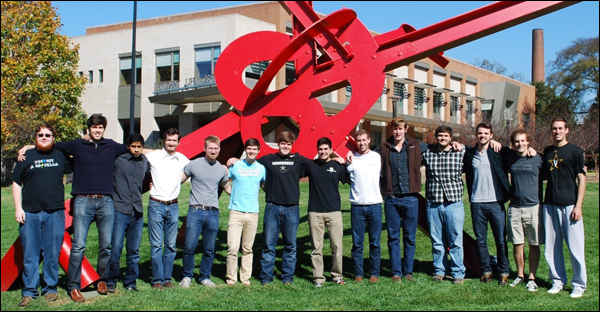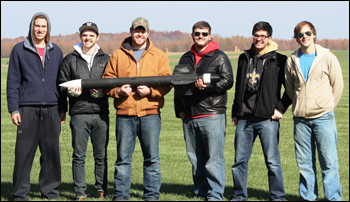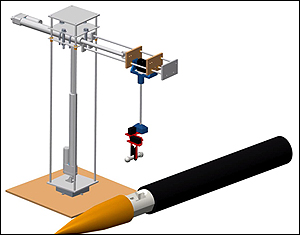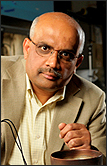
The Vanderbilt Aerospace Club, defending champions in the NASA Student Launch (NASA SL) Challenge for the past two years, is tackling the agency’s all-new 2014-15 design challenge.
The rocket team is working on an earth-simulated Mars Sample Recovery Vehicle, which includes an Automated Ground Support Equipment Robot (AGSE) that autonomously places an encapsulated soil sample in a Mars Ascent Vehicle (MAV). The ascent vehicle is eventually launched to a height of 3000 ft., with the sample independently parachuted back to Earth.
In previous competitions, teams were allowed to choose their own scientific payload designs and build appropriate rockets to carry the payloads to a mile above ground and return safely.
“NASA has standardized this year’s competition by requiring all teams to design the AGSE and the appropriate MAVs. The agency has added an optional challenge, called the Maxi MAV,” said Team Director Amrutur Anilkumar, a professor of the practice of mechanical engineering.
“The Maxi MAV challenge requires teams to design their own autonomous launch pads and ignition systems that complete the sample insertion into the rocket, and launch it in a period of 10 minutes. It is linked to the NASA Centennial Challenges Competition with the possibility of awarding major cash prizes.”
The team has decided not to participate in the optional Maxi MAV competition.
“We felt we should concentrate on aspects of the competition that would ensure on-time project completion and the most elegant design with optimal utilization of the team’s budget resources,” Anilkumar said.

The team recently tested a first model of its ascent vehicle at a Manchester, Tennessee launch site, and had a successful recovery of a mock-up payload. The launch also pointed out a few operational glitches that the team is working to perfect before the competition April 7-11 in Huntsville, Alabama. The SL challenge — now in its 15th year — is organized by NASA’s Marshall Space Flight Center in Huntsville.
“In the past years Vanderbilt has established a niche in payload design where we have won four back-back payload design awards and led the field. This year’s challenge is along a clearly delineated design challenge and it is up to us to come up with the best possible design,” said Dexter Watkins, Aerospace Club president. Watkins has returned to Vanderbilt as a graduate student in mechanical engineering following a stint as a Systems Engineer at Northrop Grumman.
“The objective of the Vanderbilt Ascent Vehicle Design is to be the lightest and the lowest drag vehicle that has the most optimal chamber for sample retention, which can handle the very high-g loads during ascent and during recovery,” said rocket design team leader Conner Caldwell, a mechanical engineering senior who has been early recruited by Deloitte Consulting to work on aerospace and defense projects.

“To achieve that optimal payload chamber, the team has developed an elegantly simple linear robotic rocket segment to open and close the nose section of the MAV. It actuates smoothly on the ground, but during flight the self-locking mechanism will effectively bolt the rocket shut into a rigid, aerodynamic structure,” said Ben Gasser, a graduate student in mechanical engineering who is mentoring the design team, along with Brian Lawson, a postdoctoral researcher in mechanical engineering.
William Emfinger and Pranav Kumar, graduate students in electrical engineering are working with senior design team on the AGSE.
“We are developing a robotic crane-based system with a powerful control processor that can handle the detection of the sample, and coordinate its placement in the rocket with optimal path planning for the maneuverable robotic gripper,” said Emfinger.
“To keep the project manageable and decrease implementation complexity, we are designing the mechanical and software systems of the AGSE to be modular, which allows for individual system components to be worked on, tested, and upgraded independently of the rest of the system,” said Kumar.
Vanderbilt is among 31 university teams competing in the NASA Student Launch, including teams from Cornell, U.S. Naval Academy, Florida, Georgia Tech, Illinois, Colorado-Boulder, North Carolina-Charlotte, Auburn, Louisville, Northwestern, Pennsylvania State, Arizona State and Iowa State. In the middle/high school category, eight teams will compete.

The Vanderbilt Aerospace Club was created in 2007 by Professor Anilkumar to meet the emerging needs of engineering students who wanted to pursue careers and advanced studies in aerospace engineering.
In collaboration with Heather Johnson, assistant professor of the practice of science education, the club has developed a robust outreach program to build STEM enthusiasm among middle and high school students in Tennessee.
The club’s membership consists of engineering upperclassmen who participate in the School of Engineering’s Senior Design Project, engineering graduate students whose research is allied to aerospace engineering, and some engineering lowerclassmen with a demonstrated interest in aerospace engineering. Robin Midgett, electronics technician in the Department of Mechanical Engineering, is the club’s safety officer and rocketry mentor. The activities of the club are funded by the Department of Mechanical Engineering.
Contact:
Brenda Ellis, (615) 343-6314
Brenda.Ellis@Vanderbilt.edu
Twitter @VUEngineering